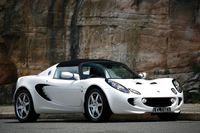Lotus Cars: Sports Cars with Economy
While car manufacturers around the world are looking at making their cars lighter and more fuel efficient, Lotus Cars is already there.
The low-volume sports car manufacturer has seen a global shift in manufacturing to emulate the philosophies and production already in place at Lotus.
Using an extruded and boned aluminium chassis weighing just 68kg and lightweight components and body panels, the Lotus Elise and Exige sports cars are known for ultimate handling and performance, but lesser recognised is their lightweight footprint on the environment.
The Lotus core philosophy of performance through light weight also has positive knock-on effects of improving fuel economy and reducing the effect on the environment. Using a modest 1.8-litre four-cylinder, its 100kW Variable Valve Timing (VVT) engine produces a combined fuel economy figure of just 8.3l/100km. Stunning figures for a sports car and it leads not only all the cars in its segment for fuel consumption and performance, but many comparable cars that are substantially more expensive.
The Elise S boasts a friendly CO2 output figure of just 196g/km, combining low emissions with stunning performance: 0-100km/h takes a scant 6.1 seconds through its five-speed gearbox. The only comparable car in terms of performance is Nissan’s 350Z that’s more expensive, 40 percent thirstier and just 0.4 seconds faster to 100km/h. And none compares to the agility and performance of sports ride and handling that Lotus is renowned for.
Weighing just 860kg, the Lotus Elise S is not just one of the lightest fully homologated sports cars in the world, but also one of the lightest cars in the world, period. Light weight has benefits for acceleration, handling, ride comfort, braking and the environment.
The new 2008 Lotus Elise SC takes performance and economy to new levels. Using a supercharger on the 1.8-litre four-cylinder, the Elise SC exhibits combined fuel consumption figures of just 8.5l/100km, which is astounding considering its power of 163kW and its ability to reach 100km/h in just 4.6 seconds.
The Lotus Exige S PP is the fastest car in the Lotus Cars Australia range with 179kW and just 935kg, mixing supercar performance with fuel economy figures of a small hatchback. With its supercharged and intercooled engine, its acceleration, handling and economy is impossible to match.
While fuel consumption may not be the highest priority in the sports car market, with fuel prices climbing, it’s nice to know the impact is lessened in a Lotus. Impressively, it may surprise some to realise the Elise is far from a stripped-out race car: standard equipment includes remote locking, power windows, air-conditioning, dual airbags and ABS alongside a host of interior features.



